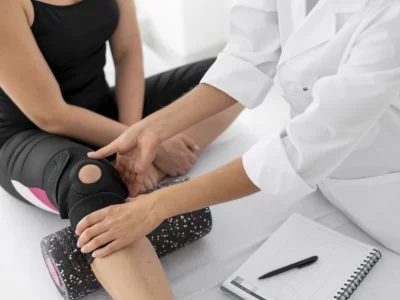Patellofemoral Pain Syndrome (PFPS), also known as runner’s knee, is a common condition characterized by pain around or behind the kneecap. It commonly affects athletes, especially runners, but can also occur in individuals who engage in activities that involve repetitive knee movements. This article will provide an overview of PFPS, including its causes, symptoms, and treatment options.
1. What is Patellofemoral Pain Syndrome?
Patellofemoral Pain Syndrome refers to pain and discomfort in the front of the knee, specifically around the patella (kneecap) and the surrounding tissues. It occurs when the patella does not move smoothly in its groove within the femur (thigh bone), causing friction and irritation. PFPS is a common condition among athletes, particularly runners, but can also affect non-athletes.
2. Anatomy of the Patellofemoral Joint
To understand PFPS, it is essential to grasp the basic anatomy of the patellofemoral joint. The patella sits in a groove at the end of the femur and acts as a fulcrum, providing leverage to the quadriceps muscle while straightening the leg. When the knee moves, the patella glides within the groove, facilitated by the surrounding soft tissues and ligaments.
3. Causes of Patellofemoral Pain Syndrome
The exact cause of PFPS is not always clear, but several factors can contribute to its development. Some common causes include:
- Muscle imbalances or weaknesses in the quadriceps, hamstrings, or hip muscles
- Overuse or repetitive stress on the knee joint
- Malalignment of the patella or the entire lower limb
- Trauma or injury to the knee
- Flat feet or high arches, leading to abnormal forces on the knee
- Joint hypermobility or laxity
4. Risk Factors for Developing PFPS
Certain factors may increase the risk of developing Patellofemoral Pain Syndrome. These include:
- Participation in high-impact sports or activities that involve repetitive knee movements
- Abrupt training or sudden increase in intensity or volume of training
- Inadequate warm-up or poor conditioning before exercise
- Previous knee injuries or surgeries
- Anatomical abnormalities, such as a shallow patellar groove or misalignment of the lower limbs
- Female gender (women are more prone to PFPS)
5. Signs and Symptoms of PFPS
The most common symptom of PFPS is pain around or behind the patella, especially during activities that involve knee flexion and extension. Other signs and symptoms may include:
- Pain worsens when climbing stairs, squatting, or sitting for extended periods
- Swelling or a sensation of grinding or popping in the knee joint
- Aching or stiffness after prolonged periods of inactivity
- Pain that gets better with rest and worsens with activity
- Difficulty performing activities that require repetitive knee movements
6. Diagnosing Patellofemoral Pain Syndrome
To diagnose PFPS, an orthopedic surgeon will conduct a thorough evaluation of the patient’s medical history, perform a physical examination, and may recommend imaging tests such as X-rays or MRI scans. The diagnosis is usually based on the patient’s symptoms, physical examination findings, and ruling out other potential causes of knee pain.
7. Treatment Options for PFPS
The treatment of Patellofemoral Pain Syndrome focuses on reducing pain, improving knee function, and addressing the underlying causes. Your orthopedic doctor may recommend the following treatment options:
Non-surgical Treatments
- Rest and activity modification to avoid aggravating movements
- Ice therapy to reduce pain and inflammation
- Compression bandages or knee sleeves for added support
- Elevating the leg to reduce swelling
- NSAIDs – Nonsteroidal anti-inflammatory drugs for pain relief
Physical Therapy
- Strengthening exercises for the quadriceps, hamstrings, and hip muscles
- Stretching exercises to improve flexibility and joint range of motion
- Patellar taping or bracing techniques to provide additional support
- Techniques to correct movement patterns and improve alignment
Medications
In some cases, medications such as NSAIDs or corticosteroid injections may be prescribed to alleviate pain and inflammation.
RICE (Rest, Ice, Compression, Elevation)
RICE is a commonly recommended approach for managing acute episodes of PFPS. Resting the knee, applying ice, using compression, and elevating the leg can help reduce pain and swelling.
Bracing and Taping
The use of knee braces or taping techniques can provide stability to the patella and improve alignment, reducing pain and preventing further injury.
Surgical Interventions
In severe cases of PFPS that do not respond to conservative treatments, surgery may be considered. Surgical options may include realigning the patella, repairing damaged cartilage, or addressing any underlying structural issues.
8. Prevention Strategies for Patellofemoral Pain Syndrome
While PFPS is not always preventable, certain strategies can reduce the risk of developing the condition. These include:
- Gradual and progressive training programs that allow for proper conditioning
- Incorporating strength and flexibility exercises into workout routines
- Using proper techniques and form during physical activities
- Wearing appropriate footwear that provides adequate support and cushioning
- Avoiding sudden increase in training intensity or duration
9. Rehabilitation and Recovery
Rehabilitation plays a crucial role in recovering from PFPS. Physical therapy programs tailored to individual needs can help restore strength, flexibility, and proper biomechanics. It is essential to follow the prescribed exercises and gradually return to activities to prevent re-injury.
10. Lifestyle Modifications and Self-Care Tips
In addition to medical interventions, certain lifestyle modifications and self-care practices can support the management of PFPS. These may include:
- Maintaining a healthy weight to reduce excess stress on the knee joint
- Engaging in low-impact activities that minimize knee strain
- Using orthotic shoe inserts to correct foot alignment and reduce abnormal forces on the knee
- Applying heat or ice as needed to alleviate pain and inflammation
- Incorporating adequate rest and recovery periods into training routines
Bottom Line
Patellofemoral Pain Syndrome, or runner’s knee, is a common condition characterized by pain around the kneecap. It can significantly impact an individual’s ability to engage in physical activities and sports. However, with proper diagnosis, treatment, and preventive measures, individuals with PFPS can find relief and return to their desired level of activity.

